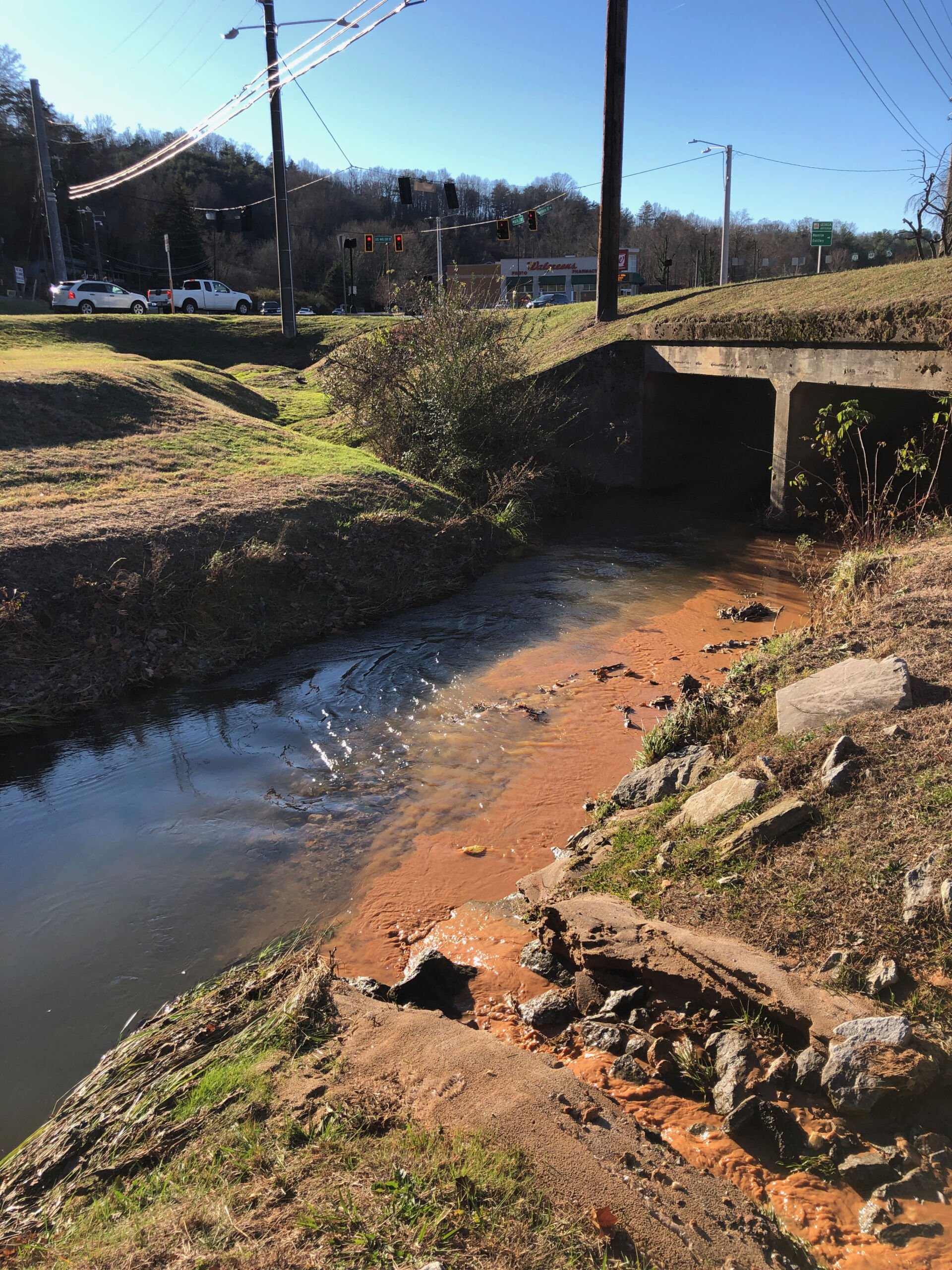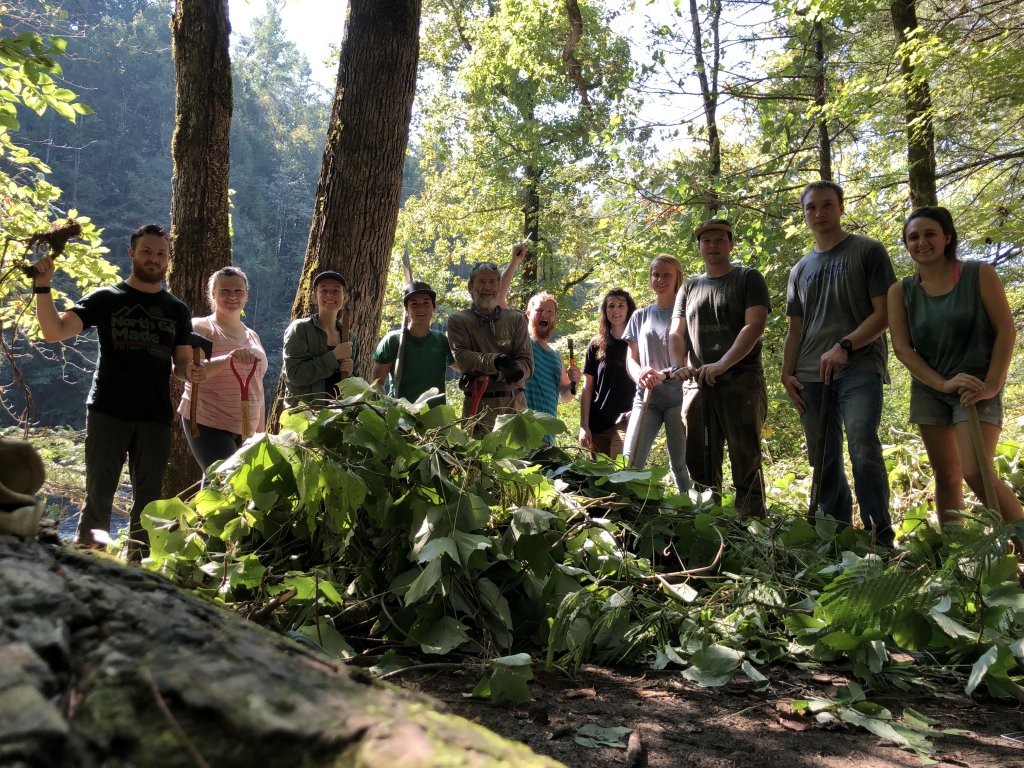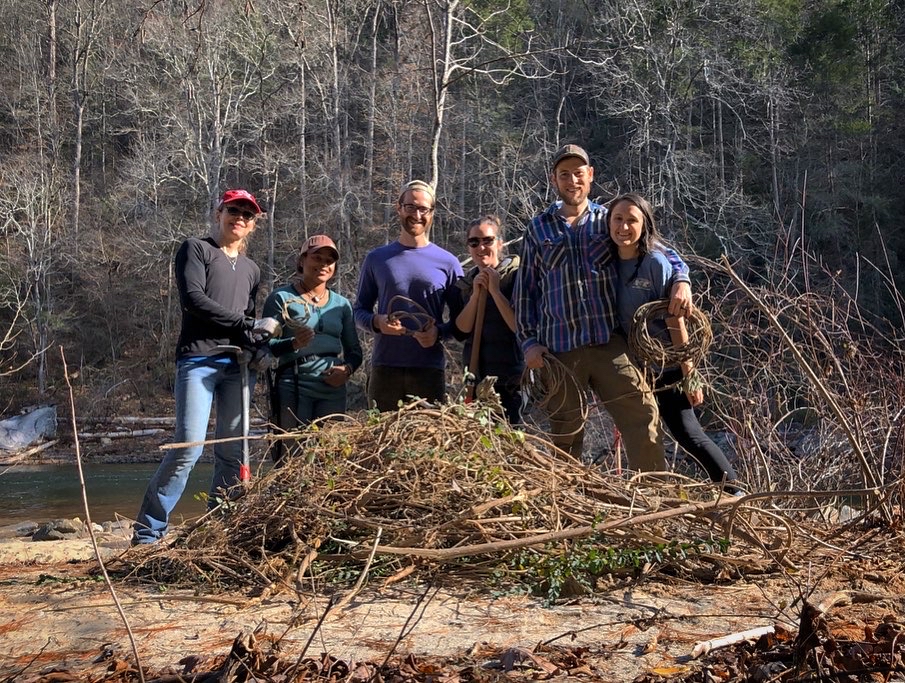By Emily Anderson
Protecting a Wild and Scenic River is a big task. The Chattooga River corridor, like many others, is managed by the US Forest Service. But stewardship—by volunteers, nonprofit organizations, outfitters, river users, etc.—is a critical part of identifying issues and needs, and working to preserve the river’s outstanding values. We all have a hand in protecting this incredible resource.
Over the years, with the help of countless volunteers and generous donors, the Chattooga Conservancy has worked to preserve and restore native ecosystems across the watershed, from rare native habitats, to polluted tributaries, to threatened species. This past year, with the help of a Wild and Scenic Rivers Stewardship Partnership grant from River Network and USFS, we were able to work with dozens of volunteers to put the spotlight on two such priorities: water quality and invasive species.
Whetstone Creek’s turbid water flows into the Chattooga River after a heavy rain.
Water Quality
It’s no secret that water quality has been an issue throughout the years, and in fact, pollution in Stekoa Creek almost kept the Chattooga from receiving Wild & Scenic River designation in the first place. Several initiatives aimed at cleaning up Stekoa over the years have started to put things on track to improve, but there is still much work to be done (read more about the issues, as well as past and ongoing efforts on our Stekoa Creek Campaign page). Today, Stekoa Creek, Warwoman Creek, Whetstone Creek, Long Creek, and several smaller tributaries remain impaired due to fecal coliform and/or sediment pollution. We’ve so far studied and developed Watershed Management Plans for the Stekoa and Warwoman Creek watersheds, but until this past summer, had never been able to put much focus on the creeks on the SC side—and we’re glad we did.
The bad news: Water sampling from August to December revealed that fecal coliform/E. coli pollution in Whetstone Creek (SC) regularly exceeded state water quality standards, even just above the confluence with the Chattooga River. One set of samples collected after a rain event actually showed too many coliform colonies to count. This pollution creates a public health hazard for Chattooga River users, especially after heavy rain when levels tended to be the highest.
The good news: Whetstone is now on our priority list. We’re currently looking for resources to try and work towards cleaning this important tributary up, both in terms of bacterial and sedimentation issues, to begin restoring this aquatic habitat.
In other good news, our sampling has helped lead to some positive results in Rabun County thanks to Clayton city officials, such as the repair of a source of fecal coliform pollution in Scott Creek, and the quick action to repair one major sediment leak into Stekoa Creek. Moving forward, we’ll be continuing our water sampling as frequently as we’re able. Keep track of all our results on our Water Quality Data page, and if you’d like to volunteer to help out, please let us know!

A ruptured water line in Clayton resulted in an outpouring of muddy water into Stekoa Creek. Crews worked quickly to repair the leak.

Kudzu nearly crossed the sidewalk on the Georgia side of the Hwy 76 bridge this summer.
Invasive Species
Non-native invasive species are persistent nuisances in many parts of the watershed, out-competing native flora and disturbing natural ecosystems. In recent years, raft guides and paddlers have increasingly been noticing a certain variety popping up along the banks of Section IV. Sandy beaches have gradually been overtaken by weaving vines that blanket nearly everything in their path: kudzu.
After some research into management methods, largely spearheaded by Molly and Buzz, we decided to get to work trying to tackle this problem last spring. Under our volunteer agreement with the Andrew Pickens Ranger District, we set to work at ‘Cigarette Beach’ with a group of volunteers digging up kudzu root crowns, along with multiflora rose, privet, and honeysuckle. It’s exhausting work, but it’s really rewarding to see native plants uncovered and once again free to grow in the sunlight.
During the WSR grant term, we developed a plan and expanded our work to the Georgia side, working in cooperation with the Chattooga River Ranger District. The Highway 76 bridge patch—the likely seed source—became top priority, and turned out to be a much bigger task than we’d anticipated. Chattooga Conservancy staff and volunteers visited this spot several times in the last few months of the year. We took a few breaks with trips to Camp Creek (thanks to Wander North Georgia staff & volunteers for helping with one of these!) and to ‘Dead Cow Beach’. It’s difficult to see the results of these efforts in the winter, but keep an eye out in the spring. We’ll be monitoring for any new growth to see which spots we need to revisit.
Helping to manage kudzu and other invasives along the river will be an ongoing effort, and we already have a list of a few beaches needing attention that we didn’t make it to last year. We’ll be sharing our plans for these work days as we get closer to growing season, so stay tuned if you’d like to get out there and help. Also, check out the latest Chattooga Quarterly if you’d like to learn more about our kudzu removal methods.
We couldn’t have done this work without the help of some wonderful volunteers. Thank you to all who have dedicated their time these last few months to help fight invasive species and monitor streams!










